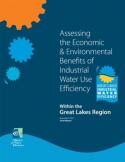Economic and Environmental Benefits of Industrial Water Use Efficiency in the Great Lakes

The Alliance for Water Efficiency, with funding from the Great Lakes Protection Fund, assessed five representative industries within the Great Lakes watershed that are supplied with treated drinking water and that discharge to a local wastewater utility. The assessments that were conducted focused on four factors:
- Potential water conservation opportunities;
- Benefits and costs from the water user’s perspective;
- The environmental benefits of undertaking those conservation opportunities; and
- A strategy for providing funding assistance to industries.
SUMMARY OF FINDINGS
The effort found significant opportunities for water savings in each of the industrial sites assessed. In these five sites alone, 66 million gallons per year could be saved, most of which would also reduce wastewater flows in a roughly equal amount. The payback time for these improvements ranged from .2 years to 5.8 years, averaging 1.2 years. The average simple return on investment across the full project was 84%.
Effects on the Great Lakes Themselves
The regional environmental benefits of these water savings include healthier aquatic ecosystems, improved stream flows and aquifer levels, and air quality improvements through reduced energy requirements for pumping.
The project examined five industries of varying size and with a variety of water sources and wastewater receiving waters. These five industries alone revealed potential water savings of approximately 560 billion gallons over the average 20-year life of the projects. The Great Lakes region is home to approximately 1,000 comparable facilities. In rough numbers, therefore, the water savings revealed could amount to roughly .2% of the potential water savings and related environmental impacts throughout the basin if applied to similar industries in the basin. While these numbers represent only a rough approximation, they are meaningful in their size and impact. Lastly, these benefits are particularly significant in stressed watersheds.
CONCLUSIONS AND RECOMMENDATIONS
- Significance of Benefits. Even in a region as water rich as the Great Lakes basin, the benefits of water conservation appear to be profound across a range of areas, including supply reliability, reduced pumping, and reduced treatment. Large-scale industrial water conservation efforts should be pursued across the nation, regardless of regional water scarcity, but care must be taken to ensure the viability of the affected water utilities.
- Untapped Opportunities. This project assessed only five industries. Other high-water-use industries, such as food processing, dairies, cheese making, meatpacking, concrete batching, and pharmaceuticals, should be explored and assessed as well.
- Protected Wastewater Stream. Filtering, treating, and re-using water on site not only reduces water consumption, in some instances, it can also remove dissolved and suspended solids and BOD from the wastewater stream.
- Explore Areas with the Potential to Have the Greatest Impact. While the benefits of conservation are apparent everywhere, they are most profound in areas with stressed supplies, especially where utilities draw water from and release water to streams or aquifers.
- Explore Utility Territories with the Greatest Potential Benefit from Conservation. Since some utilities will realize greater benefits from large-scale industrial water conservation efforts than others, those are the utilities that should be targeted in subsequent efforts. Specifically, these are utilities in either water-stressed areas or those experiencing rapid growth. The environmental benefits will have value to all regions, but not equally.
- Storm water Capture. Capturing and using rainwater on site requires minimal treatment and may be used for cooling towers, irrigation, or floor washing. This practice not only reduces the need for treated water, it also provides additional protection from storm surges and combined sewer overflow events. This practice is now a recognized Best Management Practice in the new EPA storm water programs.
- Funding Details. In addition to securing a source of dollars for the revolving fund, work also needs to be done to determine how to assess and fund those measures that balance financial return with benefits to the environment.





